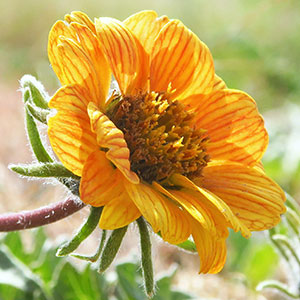Balsamorhiza
Balsamorhiza rosea
balsamroot
rosy balsamroot
erect, branched mostly from bases.
mostly basal; opposite or alternate; petiolate (bases persisting as fibrils);
blades (mostly pinnately nerved, sometimes 3- or 5-nerved) either rounded-deltate to triangular-deltate with bases sagittate or cordate to truncate and margins entire or crenate (B. subg. Artorhiza), or blades mostly elliptic, ovate, or lanceolate to lance-ovate or oblong and often 1–2-pinnatifid or -pinnately lobed with bases mostly truncate to cuneate and (if not lobed) margins usually crenate, dentate, or serrate, seldom entire (B. subg. Balsamorhiza), faces usually hirsute, hispid, pilose, puberulent, scabrous, sericeous, strigose, tomentose, or velutinous and gland-dotted or stipitate-glandular, seldom glabrous.
blades gray-green, oblong to lance-ovate, 3–10(–20) × 2–5 cm (rarely pinnately lobed), bases weakly cordate or truncate, margins crenate to serrate, apices rounded to acute, faces finely strigose to moderately scabrous (usually gland-dotted as well).
mostly campanulate or turbinate to hemispheric, 11–30+ mm diam.
hemispheric, 18–20 mm diam.
flat to convex, paleate (paleae persistent, conduplicate, at least at bases, chartaceous).
5–21+, pistillate, fertile;
corollas usually yellow to orange, rarely becoming brick red (B. rosea).
(becoming brick-red, often drying to pink or rose, and chartaceous) (8–)15(–25) mm (hispidulous abaxially; cypselae strigose).
(15–)50–150+, bisexual, fertile;
corollas yellow to orange, tubes much shorter than cylindric throats, lobes 5, ± deltate (style branches stigmatic in 2 barely distinct lines, appendages filiform).
persistent, 8–20+ in 2–3+ series (subequal to unequal, outer equaling or surpassing inner).
deltate or ovate to lanceolate, 8–12 mm, not surpassing inner.
radiate, usually borne singly, rarely (2–3+) in ± corymbiform to racemiform arrays (peduncles ± scapiform, usually bearing 2+ leaves or bracts proximally or at mid length).
usually borne singly.
obscurely prismatic, weakly 3–4-angled (faces usually glabrous, strigose in some B. careyana and in B. rosea);
pappi 0.
= 19.
= 38.
Balsamorhiza
Balsamorhiza rosea
Species 12 (12 in the flora).
Balsamorhiza ×bonseri H. St. John refers to a hybrid derivative involving B. sagittata and B. rosea. The plants have the habit of B. sagittata and the reddish ray corollas of B. rosea. The cypselae are hairy.
Balsamorhiza ×terebinthacea (Hooker) Nuttall and B. macrophylla var. terebinthacea (Hooker) A. Nelson refer to hybrids derived from B. hookeri × B. deltoidea.
In the key and descriptions here, “leaves” refers to basal leaves and “leaf blades” refers to blades of basal leaves, unless otherwise indicated.
(Discussion copyrighted by Flora of North America; reprinted with permission.)
In a hybrid swarm involving Balsamorhiza rosea and B. careyana, B. rosea remains relatively uncontaminated; the dominance among the hybrids appears to lie with B. careyana. A record of a hybrid between B. rosea and B. careyana from the Spokane area is doubtful.
(Discussion copyrighted by Flora of North America; reprinted with permission.)
1. Leaves (petioles mostly longer than blades): blades rounded-deltate or deltate to triangular-deltate, bases sagittate or cordate to truncate, margins usually entire, sometimes crenate to dentate (subg. Artorhiza) | → 2 |
1. Leaves (petioles mostly shorter than blades): blades mostly lanceolate, lance-elliptic, lance-ovate, linear-oblong, oblong, or ovate, often 1–2-pinnatifid or -pinnately lobed, bases usually truncate to cuneate, sometimes cordate, ultimate margins usually crenate, dentate, or serrate, seldom entire (subg. Balsamorhiza) | → 4 |
2. Heads usually borne singly, sometimes 2–3+; leaves ± silvery to white, faces (at least the abaxial) sericeous, tomentose, tomentulose, or velutinous | B. sagittata |
2. Heads 2–3+ or borne singly; leaves green, faces glabrous or finely hispidulous to hirtellous | → 3 |
3. Heads usually (2–)3+, sometimes borne singly; leaf margins usually entire, sometimes crenate (to dentate near bases), faces usually finely hispidulous to hirtellous (cypselae strigose or glabrous) | B. careyana |
3. Heads usually borne singly, sometimes 2+; leaf margins usually crenate to dentate (at least near bases), sometimes entire, faces usually sparsely hirtellous to hispidulous, sometimes glabrous (usually gland-dotted, sometimes vernicose; cypselae glabrous) | B. deltoidea |
4. Leaf blades sometimes pinnately lobed (ultimate margins usually crenate-serrate, dentate, or serrate) | → 5 |
4. Leaf blades usually 1–2-pinnatifid | → 6 |
5. Leaf blades (earliest sometimes, later seldom, pinnately lobed): margins usually dentate to serrate, faces hirsutulous to scabrous (ray corollas yellow, not becoming red or chartaceous; cypselae glabrous) | B. serrata |
5. Leaf blades (rarely pinnately lobed): margins crenate-serrate, faces finely strigose to moderately scabrous (ray corollas yellow at anthesis, becoming red, drying pinkand chartaceous; cypselae strigose) | B. rosea |
6. Leaves grayish, silvery, or white, faces lanate-tomentose, sericeous, tomentose, or villous | → 7 |
6. Leaves bright green to gray-green, faces glabrous or hirsute, hirtellous, hispid, hispidulous, pilose, piloso-hirtellous, scabrous, sericeous, strigillose, strigose, subvelutinous, or tomentose (sometimes gland-dotted as well) | → 9 |
7. Leaves: faces densely sericeous; n California, s Oregon | B. sericea |
7. Leaves: faces lanate-tomentose, tomentose, or villous; n California, Oregon, Washington | → 8 |
8. Leaf blades ovate to lanceolate, 10–45 × 3–7(–10) cm (1-pinnatifid, lobes ovate to lanceolate, 20–50 × 5–25 mm), margins plane; Oregon, Washington | B. incana |
8. Leaf blades lanceolate to linear-oblong, 10–20 × 3–6(–8) cm (1–2-pinnatifid, primary lobes lance-linear to oblong, 5–40 × 1–10 mm, margins revo-lute); n California | B. lanata |
9. Leaf blades 30–60 cm, 1-pinnatifid or nearly so; outer phyllaries usually much surpassing inner | → 10 |
9. Leaf blades 6–40 cm, usually 1–2-pinnatifid; outer phyllaries seldom surpassing inner | → 11 |
10. Leaves: faces strigillose to subvelutinous or tomentose (margins not cili-ate); ray laminae 20–30+ mm | B. macrolepis |
10. Leaves: faces scabrous or piloso-hirtellous to pilose (at least adaxial, mar- gins ciliate); ray laminae 35–50+ mm | B. macrophylla |
11. Leaf blades bright green, lance-elliptic to lanceolate, (6–)15–25(–40) × (3–)5–9+ cm (primary lobes lanceolate to oblanceolate, 10–45 × 2–15 mm),faces hispidulous to hirtellous | B. hispidula |
11. Leaf blades usually gray-green, narrowly to broadly lanceolate or ovate, (8–)20–30(–40) × 2–15 cm (primary lobes oblong or lanceolate to linear, 5–100 × 0.5–15 mm), faces hirsute, sericeous, or strigose | B. hookeri |


